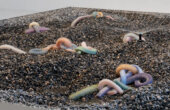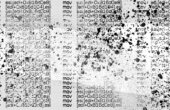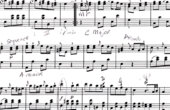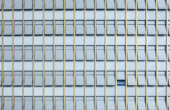'Art Is the Opposite of Spectacle': The Stunning Notebooks of Gabriel Orozco
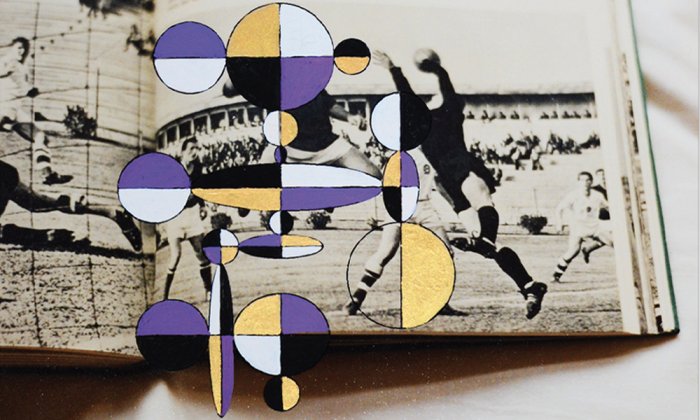
“My sculptures derive from a concrete experience, from an encounter with something in the world that interests me and with which I establish a relationship,” writes Gabriel Orozco in a June 1992 journal entry. The prolific sculptor and conceptual artist describes a destroyed marimba discovered in a junk market and reflects on a Monterrey phone book, which he stripped of names so only the phone numbers remained and reassembled to create an 82-foot record of the city. “Maybe that’s why I prefer [ordinary objects], thanks to their capacity to reveal themselves more easily to a greater number of people — their mystery lies in being commonplace.”
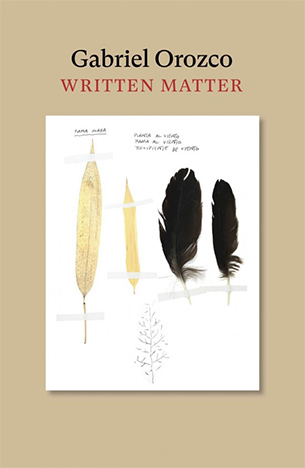
Orozco’s work has long been unified by this kind of devotion to the antispectacular, to the everyday, to the explorations of complexities that are not immediately obvious. The following entries are culled from Orozco’s book “Written Matter,” a compilation of texts, sketches, and images from almost two dozen notebooks kept by the artist between 1992 and 2012. Translated from the original handwritten Spanish, the early entries featured below — recorded in ’92 and ’93, when Orozco gained his reputation as one of Mexico’s most imaginative artists — offer personal truisms, compelling insights, observations, and notes on process and method, forming a subterranean stream that runs parallel to his artwork.
—The Editors
6 February 1992, London
Not to compose with objects but rather to make them present in the most evident way. To discover things as they are placed by chance. Chance. Imprecise accumulations. Not to compose. Art is not always composing. Nothing is perfect. My vision and criteria will always be a mistake, so why try to seek out perfection? Perfection is not truth. Art pretends to be a state of truth, therefore a state of imperfection. Not thinking about a finished art product. Knowledge and expression. Makers and gatherers. Conceptual art as the expression of feelings, appropriation of space, of objects — the physical act separated from the sculptor, painter or photographer. Poetry. Another kind of poetry. Looking for poetry or a moment of poetry. Presences. Knowledge and acceptance of what we are. To communicate with the world. Not accumulation but a sense of simplicity in the personal and singular point. of appropriation.
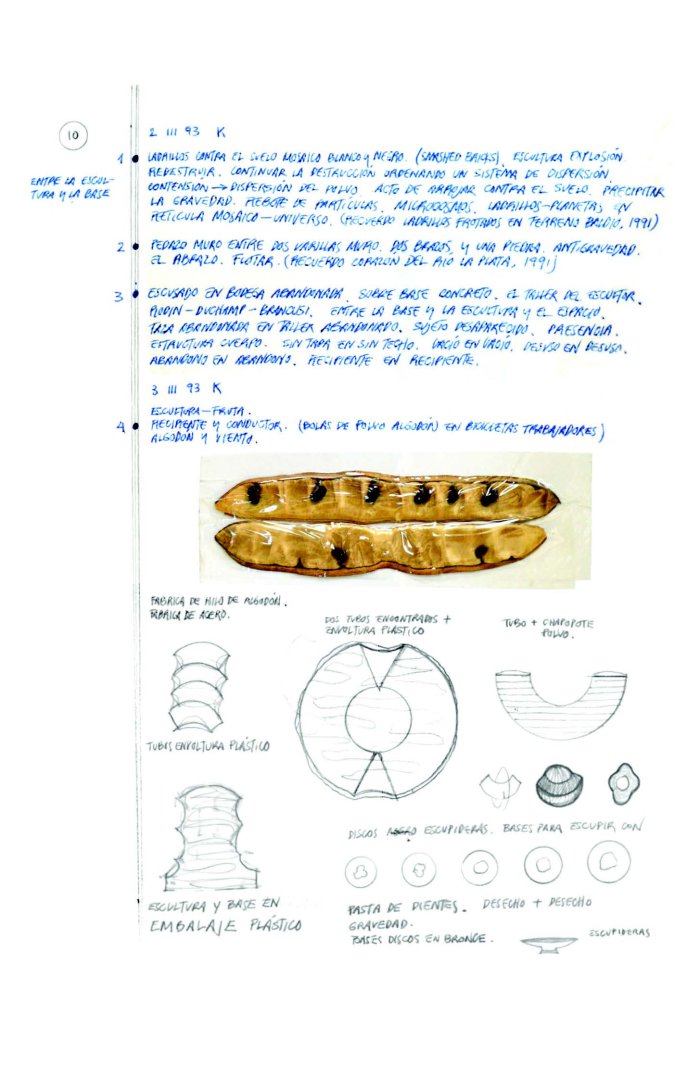
13 May 1992
The emphasis is not on the materials, but on the idea that is expressed through them. We know we can make art with anything, but now we try to seek out the possible locations for art and to describe its possibilities as a phenomenon. That is, to go beyond an affirmation of the materials and to reach the concretion of an idea through them, in a (sometimes non-traditional) space that expresses the existence of a real aesthetic, artistic or natural phenomenon. Understanding and acting upon our surroundings and broadening the fields of concretion of our ideas. It’s not about “poor” materials or “trash,” but rather about using the materials we need (high tech or low tech) in the spaces that we choose and consider adequate enough to bring about and express our ideas, and their possibilities as phenomena. Spaces can range from a museum to a sidewalk, and are chosen depending on the conceptual and material characteristics of each piece. It’s a given that to make art we can use any material, we don’t need to reaffirm that. But we do need to keep exploring the possible social, historical and geographic locations of art, as well as our attitude in relation with our surrounding reality and the possibilities of its revelation through art.
Everything can be art. Anything. And now, after knowing that, we investigate the realities of those materials (rubber, stones, papers, chairs, bicycles) and we work with them with the aim of understanding them and expressing our experience with them and it doesn’t matter whether the final result is artistic or not.
I stopped being a painter, but that doesn’t mean I have stopped painting. If I had to choose a trade to describe myself, it would be that of sculptor, although I have yet to carve a stone. But to make three-dimensional “things,” “objects,” “phenomena” is sculpture. Photography is a document, not the objective. In reality, most of my work is unphotographable. Maker, observer. Accomplice and witness of what is revealed. Technique and record. Art and reality. Arts and things. Materials (be it painting, marble, or trash) are not the objective or the common denominator — they are not genre. Ideas, our position vis à vis reality and the way in which we express our ideas are what unites us or separates us amongst artists. I feel much more distant from the discourse of many installation artists than from what many writers or sculptors tell me. Genres are created by ideas, not by materials. That is a misconception. Trash also implies accumulation and I am not sure my work is accumulative. Detritus. My materials are not detritus, they are raw material. Before, people used to walk and find stones and trees in their path. They used them. Now we walk and find concrete, iron and trash. They are our nature. We use it. But there’s also the sky, the clouds, water, bicycles and also fruit in the markets, and buildings are mountains and the wind blows, as always. Sun. We are all particles of the sun.
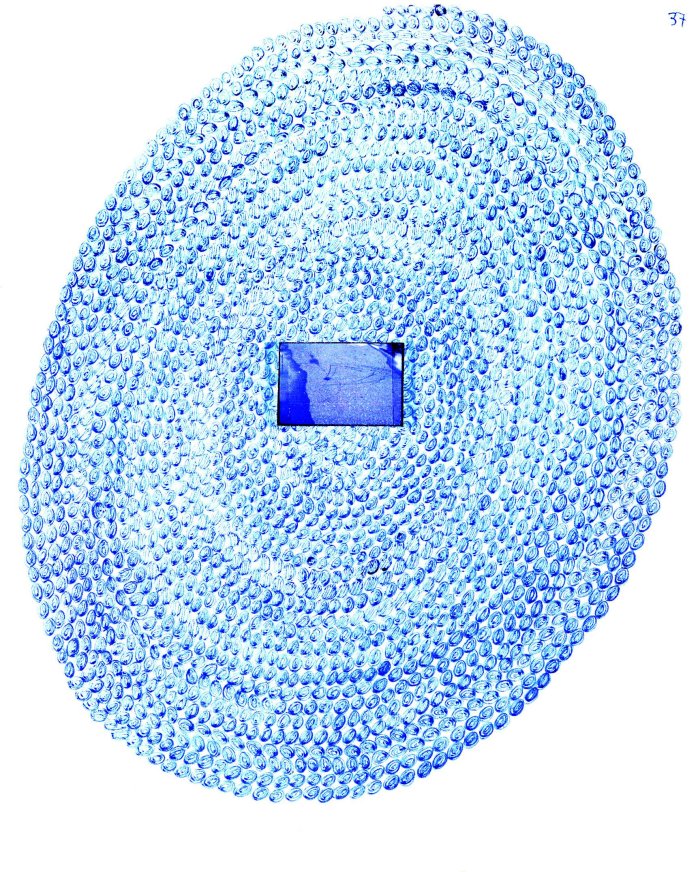
27 June 1992
My sculptures derive from a concrete experience, from an encounter with something in the world that interests me and with which I establish a relationship. A dialogue. The materials I use vary in relation to the events that affect my life. One day I found a destroyed marimba in a junk market. I had never before thought about working with a marimba. But in that moment an inescapable attraction made me buy it and begin to speculate with it until, months later, I built The Wind Instrument. Same thing happened with the rubber ball, with the anafres [portable wood or coal stoves]. With the phone book. I have now learnt not to forget the place where these pieces originated from, their “original” context in the site of encounter. It should be documented, especially when they’re objects particular to a certain culture (anafres, marimba). It may not be indispensable with the ball or the phone book. Maybe that’s why I prefer them, thanks to their capacity to reveal themselves more easily to a greater number of people — their mystery lies in being commonplace.
Bubbled bubblegum (blown up) and left disgustingly as is. Colored bubblegum on the sidewalk.
Explore: to travel in a little known region for discovery.
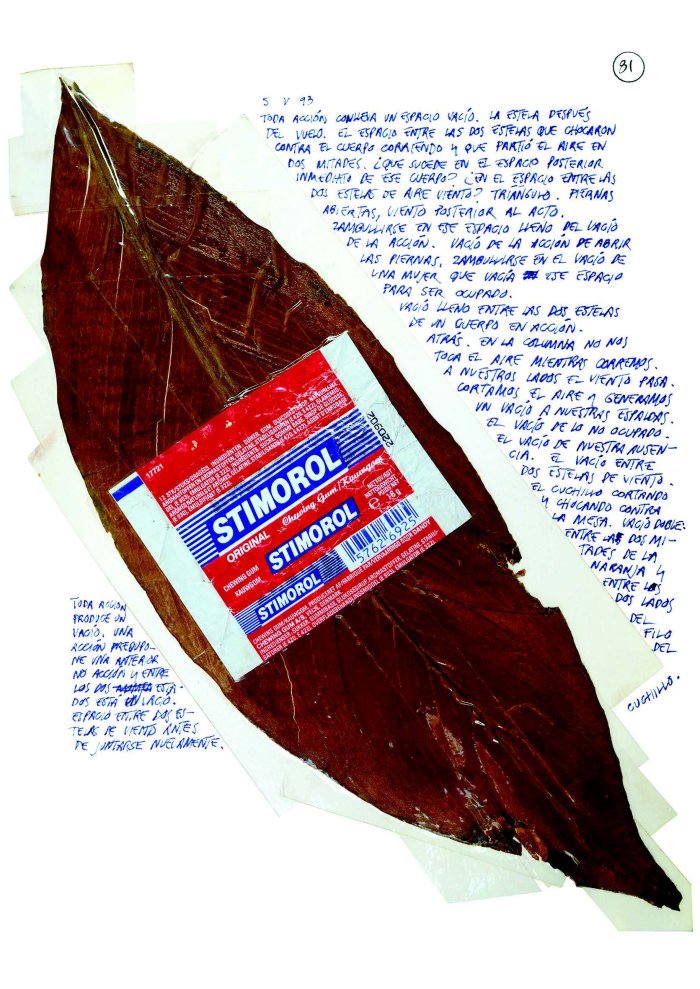
12 August 1992
John Cage died a few days ago. Two weeks ago I saw him for the last time. He gave me his autograph on the sheet of music that had been played that evening. The music was the wind, the birds, the murmur of motors and the breathing of people, accompanied by a cello or a piano. During that concert the un-extensive point of the present was heard. This morning, my body, fleeting and alone, remembers its heartbeats that day. Today, I listen to the radio and to the trucks under my window. A piano plays. And as I write this and remember Cage, the un-extensive point of the present returns. From where? And it stops, even though it has never moved. And I almost feel happy. Even though in some other place (another time) sadness awaits me, from the past.
I wish I could dance like Merce Cunningham.
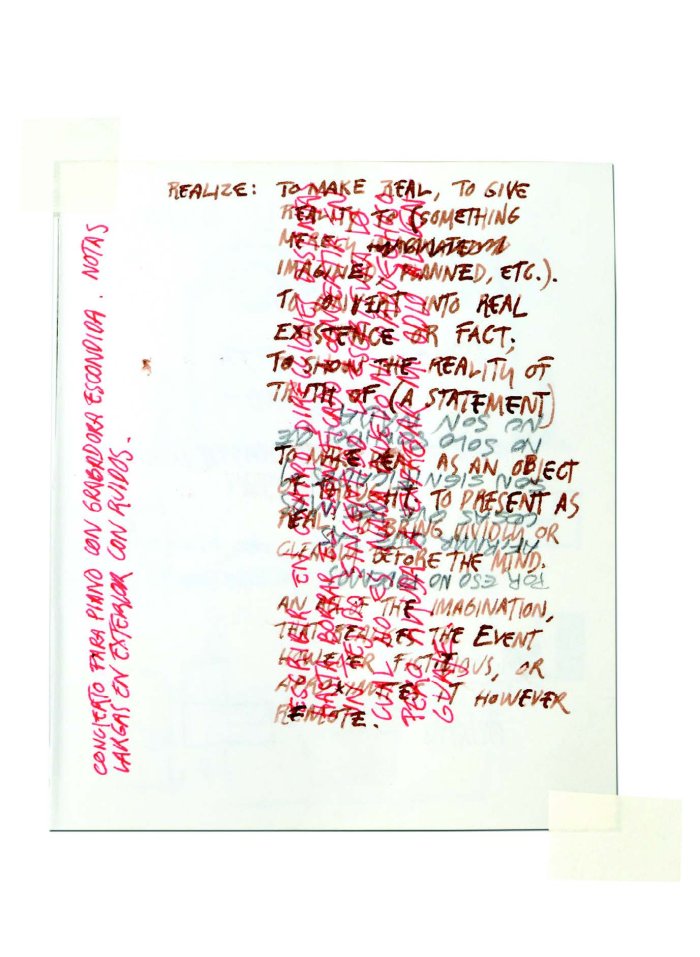
15 October 1992
To keep a found dry leaf is not the same thing as cutting a leaf and keeping it. A dry leaf is almost already a piece of paper. A leaf, attached to its plant, is a living being. Why dry it? Study. Observation. Who must we kill? Photography kills, dissects. It feigns poetry; is almost film, almost painting. It’s medicine. A serum. The worst of illusions, legitimated by our blindness and our possessive angst. Photography is not an art. Walking and knowing what is going on is an art. We see what happens, not photos. I hate photography. I hate “primitive” photographers. They use reality and make it banal with tricks. Framing is a trick. Elementary. Everything else that happens is not there, in the image. I like portraiture. Walking and observing: photography is only the documentation of that art, the art of presence. Walking, seeing and making oneself present. That thing presents itself and we can see it. It’s an art. Photography registers it (always poorly). The art of being there and perceiving what happens. The art of discovery. The art of waiting for things to reveal themselves. Of waiting for time to stop. That, and not photography, is what is dramatic.
The art of deception. Deceiving the “public,” what is that? The “general public” doesn’t exist. It’s an inconceivable abstraction. We’ll always disappoint someone. Art is deception. It’s not spectacle, it’s not entertainment. It’s a sidewalk. A light bulb, a noise. It’s no big deal. It’s a conceived deception, something almost real, boring to spectacle spectators.
I am bored. But hours don’t pass in vain. Disappointment is a sleeping dagger and I laugh. I am deceitful. Like the expectations of the spectacular spectator. I am sorry. Passionate indifference. Dry. I don’t inform, don’t explain. But I am working walking in the fleeting space between one house and the next. The art of escape: if Houdini had not deceived his audience that last night, he would not be a legend. His magnum opus was not being able to escape.
Deception. Deception brings us closer to what is most disappointing: ourselves. What we could do and our limitations. The limited public becomes unlimited with spectacle. The unlimited public is limited by art. Art is a limit. The art of limitations. Money, framing, canvas, landscape, stone, notes, alphabets are all limitations of what is infinite. The unpolished mirror and the reach of our hands. Satellites limit us, they shrink space. Space travel is disappointing. The bottom of the ocean is disappointing. Goodbye Cousteau, goodbye Apollo xi, goodbye Houdini. The artist is the disappointed hero.
I’ve never been disappointed by a woman. I am disappointed by myself, my limitations.
Walking without seeing, seeing without hearing. Armored: a blind battleship. A sailboat with a motor sails in a straight line. Turtles float. At the bottom of the ocean there is sand. A closed book is a stone.
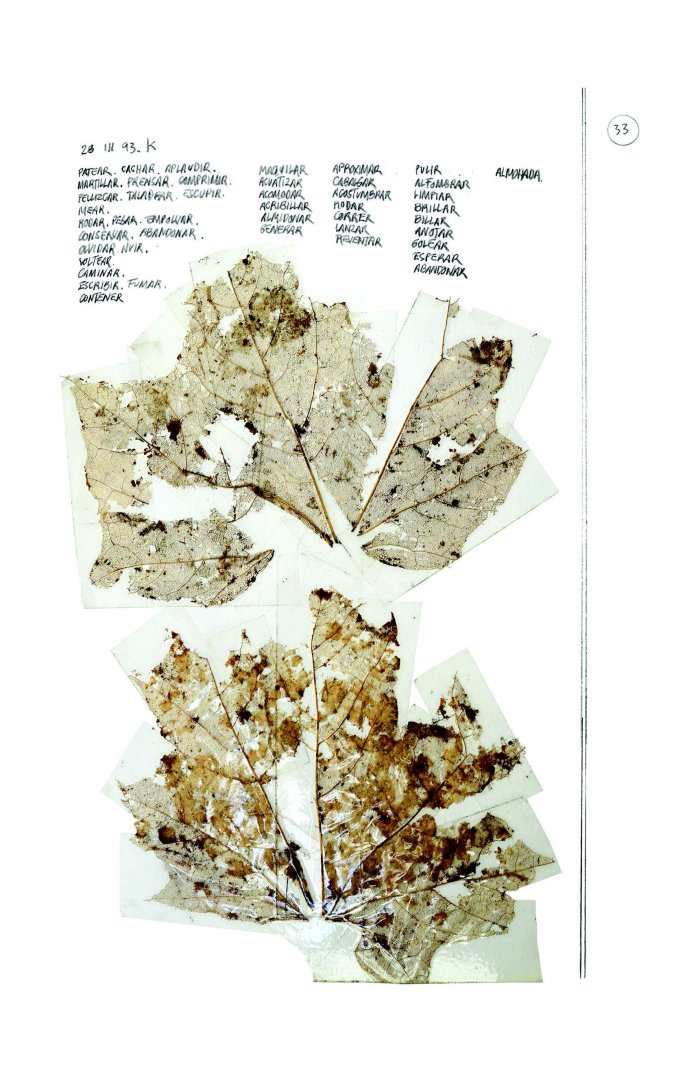
1 December 1993
Today I saw two white cups with coffee stains. The destinies of two people. Everything that will happen to them is in those stains in the hollow of the cup on a table. There were other objects: art. But what was really happening was inside those cups. Reading coffee is not necessary. Those stains are the cosmos that is happening between ourselves and everything else. Dust, bubbles, infinity.
You can only lose what you’ve never had.
30 January 1993
Always trying to find a reason to paint. A reason to justify the very pleasure of painting. I am not passionate about the result. But I’ve always felt the desire to paint. I like the smell, the physical act of painting. But I hate having an objective to meet through painting. Through art. The very fact of going to a supply store, buying a tube of fantastic colors, some wood stretchers; to pay for them and carry them all the way to the studio; to open them and smear them with one another—is that not enough? To absorb space and time. To put our desires in circulation. Consuming for the sake of consuming. To circulate for circulation’s sake. Without apparent motive. Is that not more political? (To make, to disturb.) Is this not the game of consuming and circulating through manipulated desire that justifies this society’s political system? What are the objectives? Desire and abandon. Materials by themselves say nothing. It is the way they are consumed that signifies them. Their power as signifiers depends on the system in which they circulate and how they are seen and used. This is very obvious. To buy a product to make a product. What happens in the middle? Doing what is done because it is done. Whatever is whatever. To make. To make them banal. Action. Politics in itself. Changing containers. Changing the context. Changing the products from the display window.
Half and half. Switch content tubes: Zinc white 4 lead white.
Gabriel Orozco is an internationally renowned contemporary artist. This article is adapted from his book “Written Matter.”
